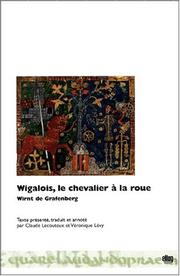| Listing 1 - 2 of 2 |
Sort by
|

ISBN: 237747215X 284310033X Year: 2021 Publisher: Grenoble : UGA Éditions,
Abstract | Keywords | Export | Availability | Bookmark
 Loading...
Loading...Choose an application
- Reference Manager
- EndNote
- RefWorks (Direct export to RefWorks)
Rédigé vers 1210 le roman de Wigalois conte l’histoire du fils de Gauvain de sa naissance à son couronnement, après maintes aventures initiatiques bien ancrées dans le merveilleux de la Matière de Bretagne et où le héros affronte géant, nain, dragon et revenants… Remontant à une source française perdue dont d’autres textes attestent l’existence, Wigalois est un témoin important qui intéressera tous ceux qui travaillent sur le roman arthurien et la sécularisation des mythes ainsi que les comparatistes.
Guinglain (Legendary character) --- Arthurian romances. --- Romances --- merveilleux --- mythe --- Gauvain --- roman d’aventure --- roman arthurien --- héros --- roman initiatique --- épique --- chevalier --- mythologie celtique --- Guinglain --- Bel Inconnu --- Fair Unknown --- Gingalain --- Gingalin --- Gliglois --- Libeaus --- Viduvilt --- Wieduwilt --- Wigalois --- German fiction --- Romances, German --- Roman allemand --- Roman courtois allemand --- History and criticism --- Histoire et critique --- Wirnt, von Grafenberg, --- Arthurian romances --- Wirnt von Grafenberg
Book
ISBN: 9004283064 9789004283060 9004269185 9789004269187 9789004269187 9004269185 Year: 2016 Publisher: Leiden, Netherlands ; Boston, [Massachusetts] : Brill,
Abstract | Keywords | Export | Availability | Bookmark
 Loading...
Loading...Choose an application
- Reference Manager
- EndNote
- RefWorks (Direct export to RefWorks)
In Imagining the Text , James Brown examines ekphrasis – the verbal representation of a visual representation – in Wirnt von Gravenberg’s thirteenth-century Arthurian romance Wigalois , one of the most popular and enduring stories in the Middle High German literary tradition. Through close reading of the text and examining illustrated Wigalois manuscripts, early print editions, and frescoes, Brown explores how ekphrasis structures the narrative, harmonizes potential conflicts in the text, and contributes to the construction of courtly identity. Imagining the Text demonstrates that the vibrant symbiosis of word and image is crucial to the poem’s sustained popularity for more than six hundred years, and contributes to the history of the book and to the study of medieval and modern modes of perception.
Ekphrasis. --- Knights and knighthood in literature. --- Guinglain (Legendary character) --- Arthurian romances --- Ecphrasis --- Art in literature --- Description (Rhetoric) --- Romances --- History and criticism. --- Wirnt, --- 091 =30 --- 094:801 --- 094:82-34 --- 091.31:7.04 --- 091.31:7.04 Verluchte handschriften: iconografie --- Verluchte handschriften: iconografie --- 094:82-34 Oude en merkwaardige drukken. Kostbare en zeldzame boeken. Preciosa en rariora-:-Sprookje. Legende. Mythe --- Oude en merkwaardige drukken. Kostbare en zeldzame boeken. Preciosa en rariora-:-Sprookje. Legende. Mythe --- 094:801 Oude en merkwaardige drukken. Kostbare en zeldzame boeken. Preciosa en rariora-:-Algemene taalwetenschap. Filologie --- Oude en merkwaardige drukken. Kostbare en zeldzame boeken. Preciosa en rariora-:-Algemene taalwetenschap. Filologie --- 091 =30 Handschriftenkunde. Handschriftencatalogi--Duits --- Handschriftenkunde. Handschriftencatalogi--Duits --- Wirnt von Grafenberg --- Guinglain --- Bel Inconnu --- Fair Unknown --- Gingalain --- Gingalin --- Gliglois --- Libeaus --- Viduvilt --- Wieduwilt --- Wigalois
| Listing 1 - 2 of 2 |
Sort by
|

 Search
Search Feedback
Feedback About
About Help
Help News
News